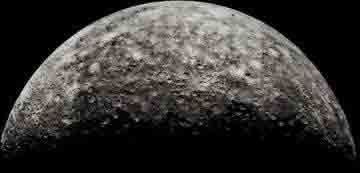|
> The Sun > Mercury > Venus > Earth > Mars > Jupiter > Saturn > Uranus > Neptune > Pluto > Comets
|
In a general sense,
Mercury is no different than our moon, and is only 40% larger. Mercury has
no atmosphere, and therefore erosion does not occur, so it has a heavily
cratered surface, as seen in the composite picture to the right. Unlike
the moon, it was not recently (recently as in 3.8 billion years ago)
resurfaced in parts, and so all the original craters are still preserved. ExplorationsReaching Mercury from Earth poses significant technical
challenges. Mercury orbits three times closer to the Sun than does Earth,
so a Mercury-bound spacecraft launched from Earth must travel over 91
million kilometers down into the Sun's gravitational potential well. From
a stationary start, a spacecraft would require no delta-v or energy to
fall towards the Sun; however, starting from the Earth, with an orbital
speed of 30 km/s, the spacecraft's significant angular momentum resists
sunward motion, so the spacecraft must change its velocity considerably to
enter into a Hohmann transfer orbit that passes near Mercury.
The only spacecraft to approach Mercury has been the NASA Mariner 10
mission (1974–75). The spacecraft used the gravity of Venus to adjust its
orbital velocity so that it could approach Mercury, and it provided the
first close-up images of Mercury's surface. It made three close approaches
to Mercury, the closest of which took it to within 327km of the surface.
Unfortunately, the same face of the planet was lit at each close approach,
resulting in the restriction of images to less than 45% of the planet's
surface. Mariner 10 also found the first evidence for Mercury's magnetic
field, and measured temperatures across its surface. [Top] Unique CharacteristicsMercury is different from all other planets in three main ways. First, it is the smallest non-controversial planet after Pluto. Therefore, it has very weak gravity, which leads to the second unique characteristic: Of all the planets in the solar system, Mercury is the only one that has little to no atmosphere. This is due to its weak gravity, which allows the solar wind to literally blow away its atmosphere. The third distinguishing feature is that its surface is completely covered with craters - even more so than Earth's moon. Since it has no atmosphere, it has no way for the craters to erode the way Earth's and Mars' craters do. Once formed, they have and will remain for billions of years, preserved by the vacuum of space. [Top] External Links:
|
